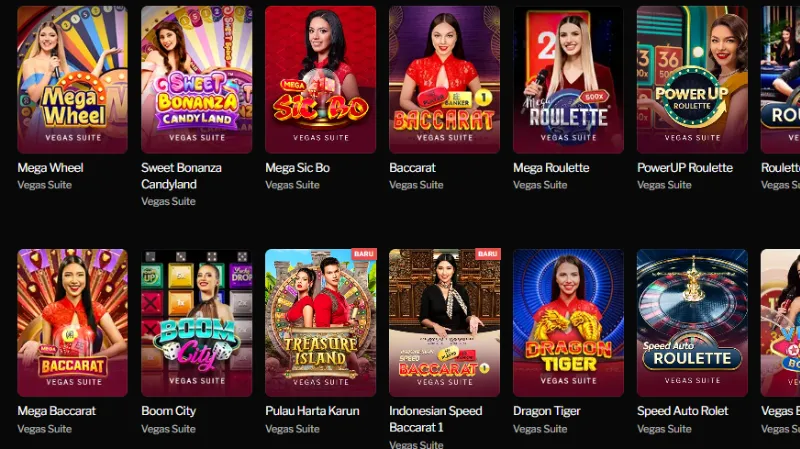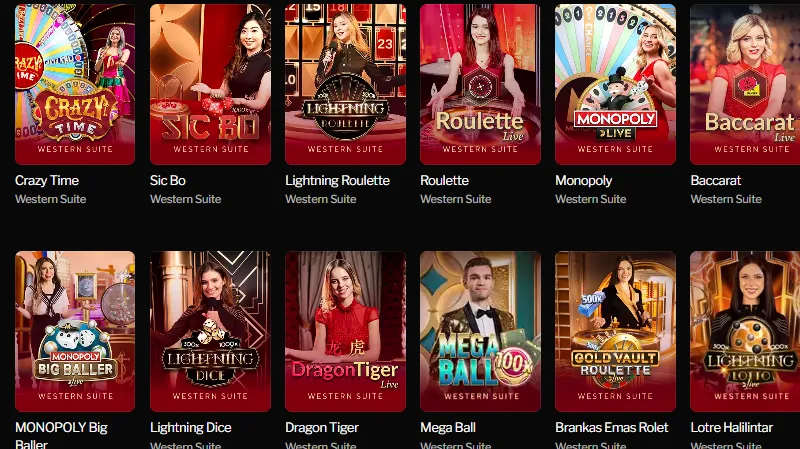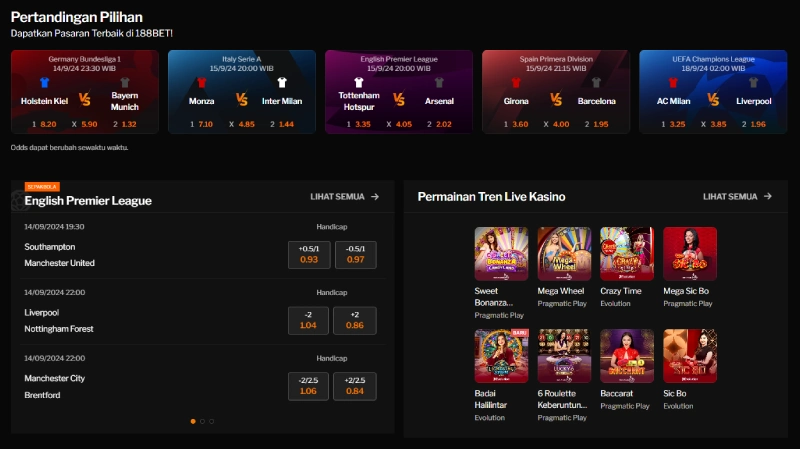188BET – Situs Judi Casino Online Link Alternatif Terpercaya Di Asia
188BET adalah situs Judi casino online terpercaya di Asia dengan link alternatif ke permainan judi baccarat, slot online, judi bola, dan togel.

Artikel ini dibuat oleh Dira Pohan, chief editorial 188BET Grand, portal media tentang taruhan live casino online terkemuka di Indonesia.
Siapa 188BET?
188BET merupakan situs judi resmi Asia yang menawarkan produk permainan casino online berupa taruhan baccarat, judi slot game, dan sportsbook (Taruhan Bola Online). disini para pemain akan mendapatkan layanan VIP super mewah yang berbeda dengan situs-situs agen pada umumnya.
Situs resmi 188BET berdiri pada tahun 2006 yang diatur oleh lisensi dari Komisi Pengawasan Perjudian Isle of Man. permainan yang tersedia didalamnya sudah melewati tahapan uji coba agar layak untuk dimainkan oleh berbagai kalangan.
Sebagai bentuk keseriusan dalam menjalankan bisnis judi casino online, pengelola selalu melakukan pembaharuan dengan menambahkan permainan-permainan dari provider (penyedia) terkenal serta terbaik di Dunia. saat ini total ada lebih dari 50 penyedia yang bekerja sama untuk menyediakan game berkualitas.
Kerjasama 188BET dengan FC Bayern
Selain itu juga , 188BET Indonesia telah bekerja sama dengan FC Bayern Munich klub raksasa asal Jerman, kampiun Bundesliga 2024/25. Sebagai regional betting partner di Asia, kami berambisi untuk menghadirkan pengalaman terbaik dalam bertaruh secara online serta mengembangkan komunitas bettor yang solid di kawasan Asia.
Rouven Kasper selaku Presiden Bayern München Asia menyampaikan secara pribadi mengenai keseriusannya dalam menyambut bergabungnya 188BET menjadi bagian dari keluarga FC Bayern. Ia menambahkan dengan kerjasama ini secara kolektif bisa menjangkau jaringan fans di Asia khususnya Indonesia, serta kedepannya bisa saling berkolaborasi untuk mencapai tujuan bersama yang lebih besar.
Untuk mendukung program kerjasama ini, 188BET Grand telah melebarkan sayapnya dengan memberikan layanan eksklusif ke lebih dari 10 negara di Asia. Indonesia, Thailand, Vietnam, China, Korea Selatan, Jepang, Malaysia, Kamboja dan India kini telah mendapatkan update terbaru yang memungkinkan para member mengakses menu taruhan menggunakan bahasa asli mereka. Tampilan antarmuka yang telah disesuaikan juga akan sangan memudahkan para bettor untuk memulai taruhan, melakukan deposit atau withdrawal dana.
Untuk minimal Deposit (pengisian dana di akun) adalah Rp. 20.000, dan tersedia metode transaksi: E-Wallet, Transfer Bank Lokal, Scan QR Code, Transaksi Virtual Account, dan waktu proses paling lama adalah 10 Menit.
Untuk minimal Withdrawal (penarikan dana di akun) adalah Rp. 100.000, dan hanya tersedia metode transaksi: Transfer Bank Lokal dengan waktu proses paling lama adalah 30 Menit.
Login Aman Lewat Link Alternatif
188BET Grand menyediakan opsi login dengan link alternatif 188BET terbaru untuk kenyamanan optimal serta kemananan akses Anda. Link login alternatif ini telah teruji bisa menanggulangi kendala proses login 188BET, sehingga dapat dilakukan secara aman. Dengan link resmi dari kami, pemain dapat menghindari situs palsu yang sengaja dibuat untuk mengelabuhi atau mengarahkan ke situs lain. Setiap tautan selalu diperbarui mengikuti perubahan situs resmi 188BET agar Anda selalu mendapatkan link login yang sah. Masuk ke akun melalui tautan alternatif ini menjamin Anda mengakses platform 188BET login yang sah tanpa hambatan. Link resmi tersebut dapat memastikan setiap login menuju situs dilakukan dengan perlindungan maksimal. Gunakan selalu tautan rekomendasi dari 188BET Grand untuk login yang aman dan terpercaya.
Untuk mendapatkan akses link alternatif beserta cara menggunakannya, kami telah menyediakan pembahasan menyeluruh yang bisa Anda lihat melalui link berikut ini :
Provider Live Judi Casino Online
XJ Live

XJ Live adalah salah satu provider live casino online di 188BET yang Dirancang dengan teknologi terbaik untuk permainan hiburan online dengan perangkat seluler pintar, menyediakan Solusi Perangkat Lunak live casino yang menawarkan pengalaman permainan Multi-Table dengan video HD. permainan yang tersedia bisa anda mainkan dengan kemudahan tiada tandingan.
Permainan yang tersedia didalam provider live casino XJ Live adalah:
- Baccarat
- Dragon Bonus Baccarat
- Multi Table Baccarat
- Roulette
- Dragon Tiger
- Sic Bo
- Three Pictures
- THAI HI LO
- XOC DIA
- Bull Bull
- Parlay
Ezugi

Ezugi merupakan penyedia (Provider) live casino online yang sangat innovatif. di 188BET Ezugi menawarkan berbagai permainan menarik yang tidak akan mudah anda temui di situs Asia pada umumnya, menjadikan mereka salah satu penyedia yang cukup unik. anda bisa menikmati tampilan permainan jernih dan jarang terjadi error karena provider ini sudah mengguankan sistem terupdate dalam mengembangkan permainan yang ada.
Permainan yang tersedia didalam provider live casino Ezugi adalah:
- Ultimate Sic Bo
- Roulette
- Baccarat
- Dragon Tiger
- Poker
- Roulette Ultimate
- Lucky 7
- Speed Fortune Baccarat
- Sic Bo
- Blackjack
- Bet on Teen Patti
- Perang Cricket
- 32 Cards
- Three Card Poker
- One Day Teen Patti
- Speed Cricket Baccarat
- Andar Bahar
- Speed Roulette
- Ultimate Andar Bahar
- Teen Patti 3 Card
Sexy Baccarat

Sexy Baccarat adalah sebuah provider live casino online mewah yang tersedia di 188BET dan dikembangkan oleh AE. Mereka mengusung tema wanita sexy untuk mendapatkan perhatian dari para pemain yang sebagian besar adaldah kaum pria. Sexy Baccarat menawarkan permainan live casio dengan dealer bikini yang menarik, dan tidak boleh anda lewatkan.
Sexy Baccarat menyediakan total 5 jenis permainan live casino:
- Baccarat
- Extra Sic Bo
- Dragon Tiger
- Roulette
- Sedie
Pragmatic Play

Pragmatic Play merupakan sebuah provider yang sudah terkenal di dunia hiburan online terutama dalam menyediakan permainan casino, salah satunya adalah live casinonya. provider ini bekeraja sama dengan 188BET hampir di semua jenis permainan yang tersedia, dan di jenis live casino ini, Pragmatic Play menyediakan total 18 permainan unik yang bisa anda nikmati.
Berikut adalah permainan yang tersedia didalam Pragmatic Play:
- Mega Wheel
- Sweet Bonanza Candyland
- 6 Roulette keberuntungan
- PowerUp Roulette
- Indonesian Speed Baccarat 1
- Mega Sic Bo
- Baccarat
- Roulette
- Blackjack
- Boom City
- Treasure Island
- Dragon Tiger
- Vegas Ball Bonanza
- Snakes & Ladders Live
- Andar Bahar
- Boom City
- Speed Auto Roulette
- Mega Baccarat
Evolution Gaming

Evolution gaming merupakan provider live judi casino online dengan nuansa rumah judi negara Barat, yang tentu saja menyediakan banyak sekali jenis permainan yang bisa anda nikmati. di 188BET, total ada 44 jenis permainan dari provider ini yang tersedia untuk anda mainkan. setiap permainan didalamnya memiliki rate kemenangan yang tinggi, sehingga banyak sekali sudah memberikan kemenangan kepada para pemain.
Berikut adalah 5 permainan unggulan dari Evolution Gaming di 188BET:
- Crazy Time
- Monopoly
- Lightning Roulette
- Mega Ball
- BlackJack
Asia Gaming

Asia Gaming adalah nama provider yang tentu saja sudah sangat dikenal oleh para pemain dari Asia terutama Indonesia. merupakan provider live casino angkatan pertama, dan setiap perubahan serta fitur yang ditambahkan sudah diikuti oleh semua pemain judi online sejak tahun 2012, dan telah menerima banyak penghargaan bergengsi sebagai penyedia permainan casino online.
Berikut adalah Permainan dari Asia Gaming yang tersedia di 188BET:
- Dragon Bonus Baccarat
- Baccarat
- Dragon Tiger
- Sic-Bo
- Roulette
- Win Three Cards
- Three Face
- Blackjack
- Bull Bull
Fitur Yang Disediakan Oleh 188BET
Login 188BET terbaru menyediakan beberapa fitur yang bisa mempermudah pemain termasuk ketika ingin mengakses, bermain, dan klaim promosi. berikut adalah beberapa fitur yang disediakan oleh situs judi online terbaik Asia ini.
Fitur Aplikasi

Fitur Aplikasi tersedia disini, anda bisa dengan mudah mengakses situs dan bermain, panduan dari pengunduan Aplikasi juga tersedia. anda yang menggunakan Smart Phone atau telepon seluler pintar dengan sistem operasi iOS, dan Andorid bisa mengunduh aplikasi ini dengan mudah. selain itu tidak ketinggalan juga bagi yang ingin menggunakan Aplikasi Web. untuk link panduan instalasi dan download APP, anda bisa klik link dibawah ini.
Fitur Permainan Pilihan

Fitur Permainan ini bisa memberikan kemudahan bagi pemain yang biasanya cukup kesulitan untuk memilih permainan yang ingin dimainkan, apalagi jika anda merupakan pemain aktif, pastinya anda ingin memiliki lebih banyak opsi pilihan permainan terbaik. 188BET mempermudah hal tersebut dengan menyediakan fitur yang juga sebenarnya merupakan rekomendasi permainan kepada anda. rekomendasi tersebut diambil berdasarkan rating serta berapa banyak pemain yang cocok bermain setelah satu kali percobaan permainan.
Kesimpulan 188BET
188BET secara aktif selalu melakukan pemeliharaan sistem untuk menjaga kualitas permainan, serta pelayanan kepada para pemain, karena kenyamanan pemain adalah hal utama dalam bisnis hiburan online ini. dengan disediakan opsi yang beragam dalam urusan transaksi dan pilihan permainan, pastinya akan menjadi sebuah nilai tambah jika dibandingkan dengan merek atau situs judi casino online lainnya.
Jangan lewatkan kesempatan anda untuk mendapatkan nuansa bermain bintang lima dari 188BET yang mempunyai harga minimal deposit (Pengisian Dana Ke Akun) yang cukup bersahabat.
FAQ (Pertanyaan Yang Sering Diajukan)
Caranya adalah anda tinggal klik salah satu tombol daftar yang tersedia di halaman ini, kemudian anda akan diarahkan ke halaman pendaftaran 188BET secara langsung. lihat langkah pendaftaran yang benar di halaman “Cara Daftar” disini.
Tidak ada biaya untuk pendaftaran, Daftar di 188BET gratis seumur hidup dan berlaku untuk semua individu di Indonesia atau pun negara lain, apabila ada pihak yang memungut biaya untuk pendaftaran di situs ini, maka anda boleh mencurigainya sebagai penipuan, dan segera laporkan kejadian tersebut ke Email yang tersedia (support-id@188service.com)
Anda bisa melakukan deposit dengan beberapa mata uang, namun juga anda melakukan deposit dengan Mata Uang IDR, maka anda disediakan beberapa metode deposit, seperti Contoh yang bisa anda lihat di halaman “Deposit dan Penarikan” disini.
Waktu proses deposit di situs 188BET adalah 1 – 10 menit, dan penarikan akan memakan waktu paling lama 30 menit. waktu tersebut berdasarkan perhitungan real, dan pihak pengelola melakukan upaya terbaik untuk membantu para member bisa mendapatkan layanan paling cepat.
Hal tersebut tidak diperbolehkan, karena akan melakukan deposit harus menggunakan rekening atas nama pemilik akun, dan pihak 188BET akan menolak proses transaksi jika member melakukan penigiriman dana menggunakan rekening atas nama pihak ke-3/lain.






